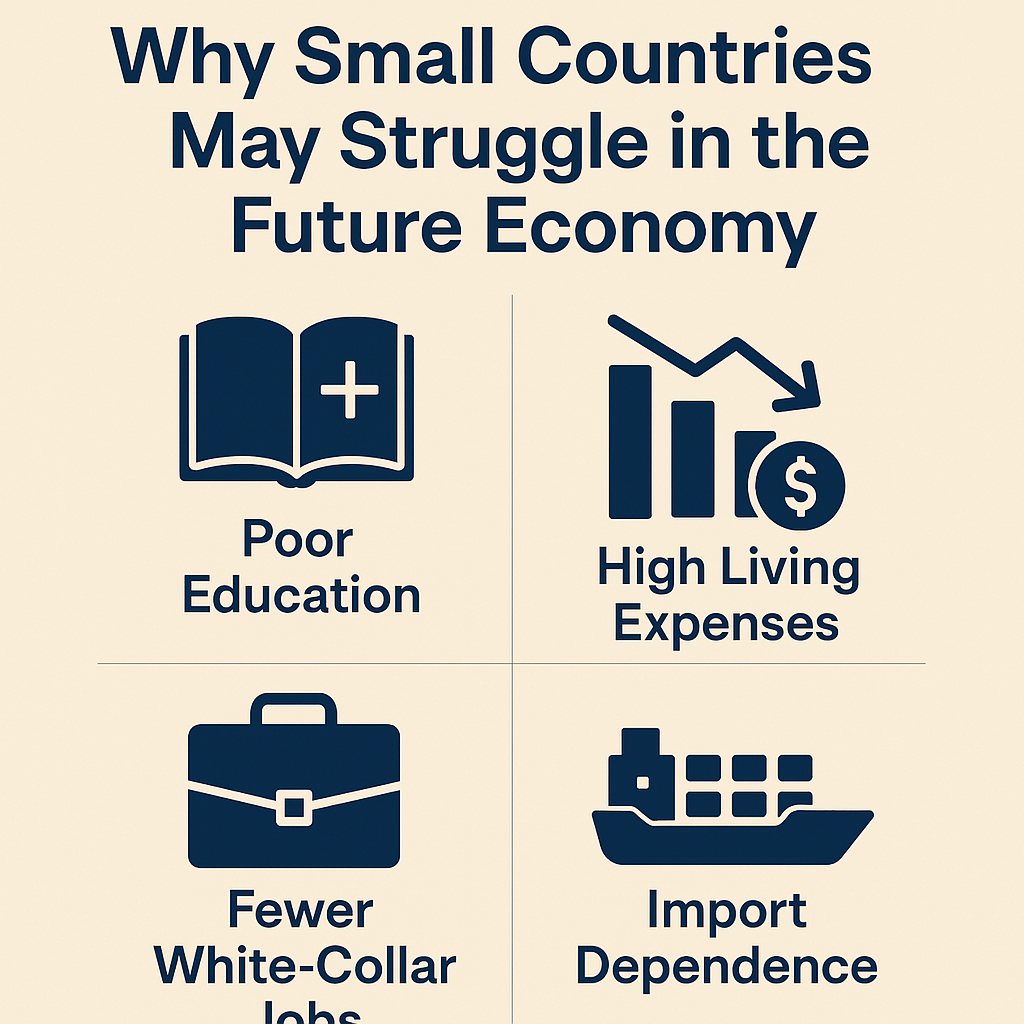Why Small Countries May Struggle in the Future Economy: A Wake-Up Call for Global Citizens
March 29, 2025 2025-04-01 9:46Why Small Countries May Struggle in the Future Economy: A Wake-Up Call for Global Citizens

Why Small Countries May Struggle in the Future Economy: A Wake-Up Call for Global Citizens
By American Study Advisor
As the world undergoes massive shifts in trade, technology, and self-sufficiency, we must start asking serious questions about where we choose to live, work, and invest. At American Study Advisor, we believe in guiding students and professionals not just academically, but strategically. Today, let’s explore a rising concern: Why small or resource-poor countries may face economic instability in the years ahead.
1. Overdependence on Imports: The Hidden Cost
Many smaller nations or those without key natural resources rely heavily on imports for essentials like food, fuel, electronics, vehicles, medicine, and clothing. This creates a fragile economy that is vulnerable to international tariffs, shipping disruptions, or political conflict.
Countries like Canada, Australia, and New Zealand, while economically advanced, still rely on imports for many daily necessities. This makes the cost of living higher and puts pressure on working-class families.
2. Fewer White-Collar Job Opportunities
Smaller countries often have limited industries, resulting in fewer high-paying professional jobs. As automation and AI begin to replace repetitive roles, the lack of a tech-driven or innovation-based economy becomes more apparent.
Meanwhile, countries like the USA, China, India, and Japan are growing rapidly in medicine, software, artificial intelligence, space research, and defense—sectors that create massive white-collar employment.
3. Education Systems Under Pressure
Without a large tax base or robust economy, smaller countries may struggle to invest in world-class education. Brain drain is a constant issue, where their brightest minds leave for better opportunities abroad.
Larger nations, on the other hand, invest heavily in universities, research centers, and global innovation hubs. The result? A cycle of growth that keeps attracting talent and capital.
4. The Rise of Economic Nationalism: Tariffs and Trade Barriers
The U.S. recently imposed tariffs on goods from Europe and other regions, signaling a broader global shift: countries want to become self-sufficient.
This is not just politics. It’s a survival strategy. The COVID-19 pandemic exposed how dangerous it is to rely on foreign countries for essentials. As a result, nations like the USA, India, and China are focusing on producing their own goods.
Smaller export-reliant nations could suffer as demand for their products drops due to these trade shifts.
5. Population Decline and Market Size
European countries like Germany, France, and the UK are facing population stagnation or decline. Fewer people mean fewer consumers, which directly impacts GDP and business growth.
In contrast, countries like India, China, and the USA have large, young populations—creating a self-sustaining market that can support industries without relying heavily on exports.
6. What This Means for Students and Professionals
As global dynamics change, it’s critical to think beyond just university rankings or weather preferences. Consider:
- Will the country still offer jobs in 10 years?
- Can the economy support innovation?
- Is the education system growing or declining?
- Is it expensive to live there, and why?
At American Study Advisor, we help you not just choose a college—but choose a future. The USA, with its economic diversity, innovation ecosystems, and market strength, continues to be one of the most promising destinations for long-term success.
7. Are There Other Countries Like USA, China, India, and Japan?
These four nations stand out due to their mix of population, resources, innovation, and economic power. But some other countries show partial strength:
- Russia: Rich in resources and military strength, but limited by political isolation and sanctions.
- Brazil: Vast land and population, strong in agriculture, but lacks infrastructure and innovation leadership.
- South Korea: Technologically advanced and a leader in electronics, but dependent on exports and lacking natural resources.
- Indonesia: Large population and growing manufacturing base; potential future powerhouse but still developing.
- Turkey: Strategic location and a growing defense sector; however, economic instability remains a concern.
These nations have strong potential but may not yet match the full self-reliant capacity of the big four. Their futures will depend on how well they navigate global shifts in trade, innovation, and internal development.
Conclusion: A New Era of Self-Sufficiency
We are entering a world where self-reliance is more valuable than global dependency. Countries that can feed, educate, employ, and protect their populations without heavy reliance on imports will lead the next generation.
If you’re a student, parent, or investor, now is the time to align with nations that are preparing for that future. Countries like the USA, India, China, and Japan are not just surviving—they’re building the foundation of the future world economy.
Let American Study Advisor help you be part of that journey.
To learn more about how we guide students to successful careers in the USA, visit: https://americanstudyadvisor.com
© 2025 American Study Advisor. All rights reserved.







